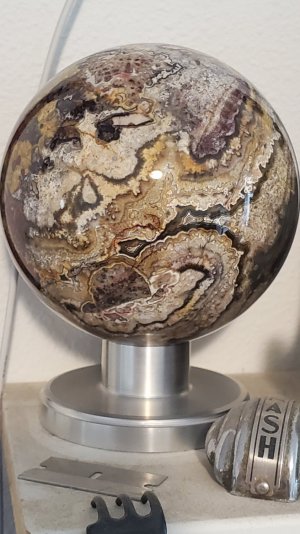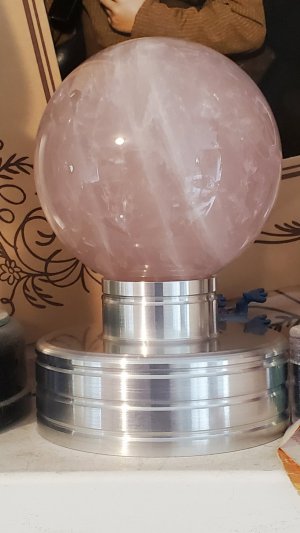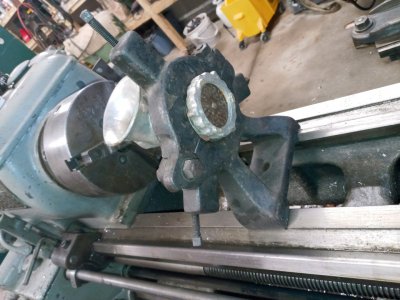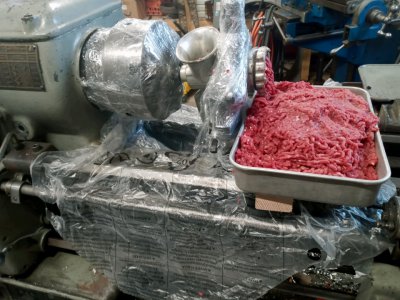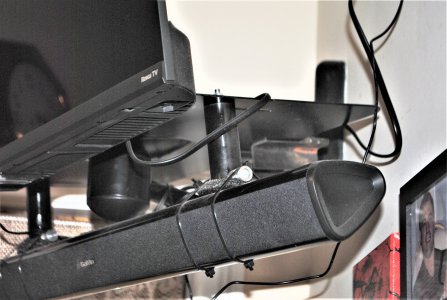-
Welcome back Guest! Did you know you can mentor other members here at H-M? If not, please check out our Relaunch of Hobby Machinist Mentoring Program!
You are using an out of date browser. It may not display this or other websites correctly.
You should upgrade or use an alternative browser.
You should upgrade or use an alternative browser.
What do you make with your lathe and mill that's not tooling, a jig or fixture, but something that is useful to the average person?
- Thread starter ARC-170
- Start date
- Joined
- Dec 9, 2021
- Messages
- 735
We were living in the house I was born in, was 100 years old, and I believe was made of lumber that the sawmill on the homestead couldn't sell. No insulation, bad windows. old wiring, failing plumbing, no foundation, and a shake roof on its last legs. We had to do something, but the Great Recession had ruined the market for our logs, which was our main source of income.
We had savings, and decided to use it to build a 40 x 100 foot all-steel shop building and make one end of it into a two-story "apartment" to live in until things turned around and we could build on the site of the old house. Once we had moved in, our twins (a boy and a girl) loved not having to share a bedroom, and we actually had insulation! We made the interior sort of "industrial" by leaving the I-beams exposed, using rubber baseboard and applying a clear epoxy finish on the concrete slab floor.
One place my wife insisted on making nice was the kitchen, and she found a deep double sink and flexible-head faucet at Ikea that she liked. The problem was that it was designed for a countertop with integral backsplash, and had a brace that needed to attach fairly high on that backsplash. Since she insisted on having a window over the sink, there was no place to attach the brace.
After giving it some thought, I figured that if I could attach something to the window sill, I could make an adapter to connect to the brace. I prowled the scrap metal yard, and came up with a couple of large satinless steel bolts that could supply material for the adapter. I turned the larger bolt to a diameter large enough to allow me to make a pocket in one side for my threaded adapter to nestle into. I also drilled and tapped the bottom for a stud that had machine threads on one end and wood threads on the other. After contouring the upper end of the adapter and using an end mill to make the pocket, I made an adapter to lengthen the brace, which had a metric thread on the female end and a NC thread going into the pocket.
It all turned out pretty well. It has been in service for 12 years now. We still haven't built the new house, because this one is so comfortable, and laid out to be so livable. We just installed a 19 KW solar system that feeds the power grid and they credit us against the power we use when it isn't putting out as much as we use.
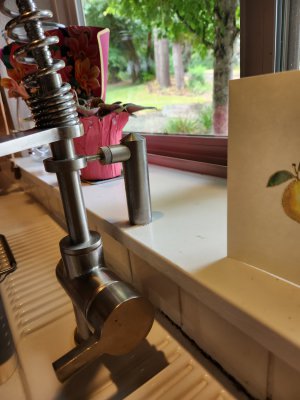
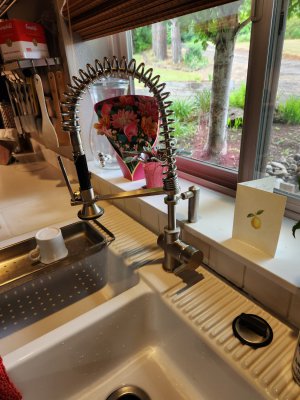
We had savings, and decided to use it to build a 40 x 100 foot all-steel shop building and make one end of it into a two-story "apartment" to live in until things turned around and we could build on the site of the old house. Once we had moved in, our twins (a boy and a girl) loved not having to share a bedroom, and we actually had insulation! We made the interior sort of "industrial" by leaving the I-beams exposed, using rubber baseboard and applying a clear epoxy finish on the concrete slab floor.
One place my wife insisted on making nice was the kitchen, and she found a deep double sink and flexible-head faucet at Ikea that she liked. The problem was that it was designed for a countertop with integral backsplash, and had a brace that needed to attach fairly high on that backsplash. Since she insisted on having a window over the sink, there was no place to attach the brace.
After giving it some thought, I figured that if I could attach something to the window sill, I could make an adapter to connect to the brace. I prowled the scrap metal yard, and came up with a couple of large satinless steel bolts that could supply material for the adapter. I turned the larger bolt to a diameter large enough to allow me to make a pocket in one side for my threaded adapter to nestle into. I also drilled and tapped the bottom for a stud that had machine threads on one end and wood threads on the other. After contouring the upper end of the adapter and using an end mill to make the pocket, I made an adapter to lengthen the brace, which had a metric thread on the female end and a NC thread going into the pocket.
It all turned out pretty well. It has been in service for 12 years now. We still haven't built the new house, because this one is so comfortable, and laid out to be so livable. We just installed a 19 KW solar system that feeds the power grid and they credit us against the power we use when it isn't putting out as much as we use.


Last edited:
- Joined
- Aug 2, 2020
- Messages
- 564
- Joined
- Apr 13, 2023
- Messages
- 201
I'm builfing my house right now, and used my mill to help fabricate the posts that hold the hand rails. I needed 18 accurately located holes for the stainless wire to go through, in each post. Once the house is done, I'll have more shop time.
I'll lso use the mill to fabricate a toilet flange, to correct for a pipe that isn't perfectly plumb.
That said, I don't really care if I make something useful with it, as machining is a hobby. If I played golf, I wouldn't care about my clubs being useful. It's my money that bought all of the equipment, my space where it all sits and my time. My GF is very supportive of the things that keep me happy, including machining time.
I'll lso use the mill to fabricate a toilet flange, to correct for a pipe that isn't perfectly plumb.
That said, I don't really care if I make something useful with it, as machining is a hobby. If I played golf, I wouldn't care about my clubs being useful. It's my money that bought all of the equipment, my space where it all sits and my time. My GF is very supportive of the things that keep me happy, including machining time.
My lovely wife has asked me what I need a lathe and a mill for. I originally bought them because I was teaching an engineering/shop class and wanted to have something at home so I could experiment and "play" while creating projects for my students. However, that program was shut down (don't get me started!).
Anyway, I was wondering what you all have made that that is useful for around the house with your machines? Have you fixed anything and saved money on repairs or the purchase of a replacement? Made anything for anyone that they needed/couldn't buy/didn't want to pay for?
So far, all I've made is mounting blocks for my DRO's, bushings for my grinder wheels and a machinist's V-block (and that was for an assignment in a class I was taking). We have a toilet paper roll holder that broke and I fixed it temporarily with a bolt, so that is on tap to make, but I thought I'd see what others made so the next time she asks me I have another answer besides them being for work if they ever bring back the program, or a hobby.
My lovely wife has asked me what I need a lathe and a mill for. I originally bought them because I was teaching an engineering/shop class and wanted to have something at home so I could experiment and "play" while creating projects for my students. However, that program was shut down (don't get me started!).
Anyway, I was wondering what you all have made that that is useful for around the house with your machines? Have you fixed anything and saved money on repairs or the purchase of a replacement? Made anything for anyone that they needed/couldn't buy/didn't want to pay for?
So far, all I've made is mounting blocks for my DRO's, bushings for my grinder wheels and a machinist's V-block (and that was for an assignment in a class I was taking). We have a toilet paper roll holder that broke and I fixed it temporarily with a bolt, so that is on tap to make, but I thought I'd see what others made so the next time she asks me I have another answer besides them being for work if they ever bring back the program, or a hobby.
- Joined
- Feb 1, 2015
- Messages
- 9,622
I installed a new hand rail to replace the rickety 110 y.o. rail that was too short for safety. The railing was made from clear vertical grain Douglas fir fir the newel posts and upper and lower rails. The balusters are 3/4" powder coated aluminum tubing. To mount the newel posts, I used 4" x 4" x 1/4" steel plates with 3/8-16 coupling nuts welded to the bottom and inletted into the floor so they were flush. Lengths of 3/8- 16 threaded rod feed up through the center of the newel post and nuts in a reverse counterbored hole, accessed through a side hole that was also access the the screws fastening the lower railing. In order to align the holes accurately, the newel posts were mounted on the cross slide of my G0602 lathe and fed into the drill bit and reverse counterbore. bit.
Holes for the balusters were bored in the rails using a 3/4" Forstner bit, using the RF30 clone. A jig was made to keep the holes centered and properly spaced. The railing section of the stairs was at a 33.4º angle so a jig was made to hold the rails sat a 33.4º angle and properly space the baluster holes.
The ends of the newel posts have a 1/2" fillet but were too awkward to cut with either the router table or the hand router so I clamped the posts to the bed of my Tormach CNC to accurately make the fillets. I used the Tormach because of the 10,300 rpm spindle speed as opposed to the 2600 rpm maximum speed of the RF30 clone.
Yet to be made are twenty rosettes to plug the various screw holes. They are being turned out of the Douglas fir on the lathe with the cap profiles cut on the Tormach CNC.
The installed railing meets current safety codes and is rock solid.
Aside from traditional woodworking tools like the radial arm saw, the table saw, the compound miter saw, the jointer, the planer, and the router, the machine shop tools used in this project were both mills, the lathe, and the drill press.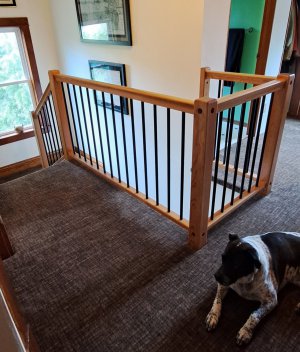
Holes for the balusters were bored in the rails using a 3/4" Forstner bit, using the RF30 clone. A jig was made to keep the holes centered and properly spaced. The railing section of the stairs was at a 33.4º angle so a jig was made to hold the rails sat a 33.4º angle and properly space the baluster holes.
The ends of the newel posts have a 1/2" fillet but were too awkward to cut with either the router table or the hand router so I clamped the posts to the bed of my Tormach CNC to accurately make the fillets. I used the Tormach because of the 10,300 rpm spindle speed as opposed to the 2600 rpm maximum speed of the RF30 clone.
Yet to be made are twenty rosettes to plug the various screw holes. They are being turned out of the Douglas fir on the lathe with the cap profiles cut on the Tormach CNC.
The installed railing meets current safety codes and is rock solid.
Aside from traditional woodworking tools like the radial arm saw, the table saw, the compound miter saw, the jointer, the planer, and the router, the machine shop tools used in this project were both mills, the lathe, and the drill press.

Kinda hard to say. I find myself looking up to the average person most of the time. After all, I am the only person that has been asked NOT to sing at church, and Boo Boo bear assured me that I am NOT smarter than the average picnic basket.
My daughter carved out today on my schedule. She drove down from Fort Worth and wanted me to cut a whiskey bottle for her so that she could put it to use. She is very interested in plants and wanted a "stylish" vessel to propagate new new plant start ups.
So I don't know if this is something the average person would find useful, but I jump at the chance to do stuff for my daughter. After all, I have run off so many boyfriends over the years, I reckon I owe her that much.....................
Used the mini mill. Bought a 4" diamond abrasive blade on fleabay for $7 and fit it on my slitting saw arbor. Put down a piece of pressed cardboard on the table, in this case it was a piece off the packaging of a case of diet coke. This allowed a bearing surface for me to rotate the bottle on the cardboard without marking the table. Used a small amount of water as mist coolant to keep the cutter clean and the chips flowing out. Ran the spindle at 400 rpm and made several rotations with the bottle until the cutter just broke through. Sanded the edges of the glass to make it safe and Bob's your uncle.
I usually try and stop just short of cutting through. Get close, then pour a little boiling water on the cut and it breaks clean. This bottle was not as thick as I expected it to be.
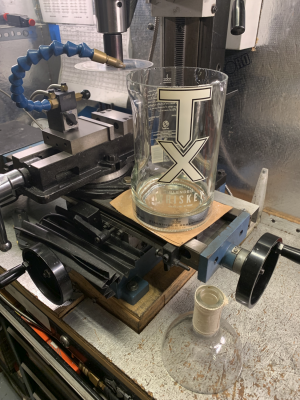
My daughter carved out today on my schedule. She drove down from Fort Worth and wanted me to cut a whiskey bottle for her so that she could put it to use. She is very interested in plants and wanted a "stylish" vessel to propagate new new plant start ups.
So I don't know if this is something the average person would find useful, but I jump at the chance to do stuff for my daughter. After all, I have run off so many boyfriends over the years, I reckon I owe her that much.....................
Used the mini mill. Bought a 4" diamond abrasive blade on fleabay for $7 and fit it on my slitting saw arbor. Put down a piece of pressed cardboard on the table, in this case it was a piece off the packaging of a case of diet coke. This allowed a bearing surface for me to rotate the bottle on the cardboard without marking the table. Used a small amount of water as mist coolant to keep the cutter clean and the chips flowing out. Ran the spindle at 400 rpm and made several rotations with the bottle until the cutter just broke through. Sanded the edges of the glass to make it safe and Bob's your uncle.
I usually try and stop just short of cutting through. Get close, then pour a little boiling water on the cut and it breaks clean. This bottle was not as thick as I expected it to be.




